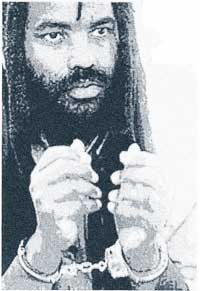
Follow workers.org on



RED HOT: TRAYVON MARTIN
CHINA,
AFGHANISTAN, FIGHTING RACISM, OCCUPY WALL STREET,
PEOPLE'S POWER, SAVE OUR POST OFFICES, WOMEN, AFRICA,
LIBYA, WISCONSIN WORKERS FIGHT BACK, SUPPORT STATE & LOCAL WORKERS,
EGYPT, NORTH AFRICA & MIDDLE EAST,
STOP FBI REPRESSION, RESIST ARIZONA RACISM, NO TO FRACKING, DEFEND PUBLIC EDUCATION, ANTI-WAR,
HEALTH CARE,
CUBA, CLIMATE CHANGE,
JOBS JOBS JOBS,
STOP FORECLOSURES, IRAN,
IRAQ, CAPITALIST CRISIS,
IMMIGRANTS, LGBT, POLITICAL PRISONERS,
KOREA,
HONDURAS, HAITI,
SOCIALISM,
GAZA



|
|
‘Race Against Death’ in Mumia Abu-Jamal’s case
By
Betsey Piette
Philadelphia
Published Apr 12, 2007 10:18 PM
In the latest attempt by the state to deny his legal rights and derail
political prisoner Mumia Abu-Jamal’s appeal of his 1982 death penalty
conviction, prosecutors have called on the entire Third U.S. Circuit Court of
Appeals to recuse itself from hearing Abu-Jamal’s case in Philadelphia on
May 17.
One of Abu-Jamal’s pending appeals cites routine practices of
Philadelphia prosecutors that are racially discriminatory. In his case, this is
specifically racial discrimination during jury selection. At the time of the
trial, Pennsylvania’s Governor Ed Rendell was the elected district
attorney in Philadelphia. Rendell’s wife Marjorie Rendell currently
serves as a judge on the Third U.S. Circuit Court of Appeals.
Instead of simply asking that Marjorie Rendell recuse herself, a move that the
defense might favor, prosecutors say “they want to avoid any possible
grounds for future appeal” by removing the entire court. They show no
concern that Ed Rendell, as Pennsylvania’s governor, can reissue a death
warrant should Abu-Jamal’s appeals be denied.
From the moment that Mumia Abu-Jamal was arrested for the Dec. 9, 1981,
shooting of a Philadelphia police officer, the bourgeois state—police,
courts, prison and media—has used every means at its disposal in its
drive to convict an innocent man.
“The history of the criminal case of Mumia Abu-Jamal, which is by now
almost 25 years old, has been characterized by bias right from the start:
against a Black man whom the court denied a jury of his peers, against a member
of the economic underclass who did not have a real claim to a qualified
defense, and against a radical, whose allegedly dangerous militancy obliged the
state to eliminate him from the ranks of society.”
So writes German author Michael Schiffmann in his new book, “Race against
Death—Mumia Abu-Jamal: a Black Revolutionary in White America,”
just released in Germany this past month.
Schiffmann’s book builds upon evidence presented by two earlier books
written about Abu-Jamal’s case: Dan Williams’ 2001 “Executing
Justice” and Dave Lindorff’s 2003 “Killing Time,” and
presents new evidence as well.
While researching his book last year, Schiffmann discovered two photographs on
the Internet taken by Pedro Polakoff, the only press photographer present at
the 1981 crime scene. Polakoff arrived 12 minutes after hearing about the
shooting on the police radio and ten minutes before the arrival of the police
unit responsible for forensics and photographs. No photographs had been taken
by the police unit when Polakoff left 45 minutes later.
A picture worth a thousand words...
Three of Polakoff’s original shots were published in Philadelphia
newspapers at the time. Schiffmann then published in his book five of the full set of 26 photos Polakoff gave him access to, demonstrating the following three points:
1) “The cops manipulated evidence and supplied the trial court with stuff
that was simply stage-managed. On Polakoff’s photos, P.O.
Faulkner’s police hat at first is clearly on the roof of Billy
Cook’s VW, and only later on the sidewalk in front of 1234 Locust where
it was photographed by the police photographer who arrived 10 minutes after
Polakoff!
2) “In court, Police Officer James Forbes claimed that he had
‘secured’ the weapons of both Faulkner and Mumia without touching
them on their metal parts in order to not destroy potential fingerprints.
However, in the single photo reprinted in the book you can see that Forbes is
touching the weapons on their metal parts, and quite a few of Polakoff’s
other photos make it clear that Forbes touched and smudged these weapons all
over, destroying any potential fingerprint evidence that may have been on
them.
3) “The second-most important prosecution witness, cab driver Robert
Chobert, simply was not parked in the spot, allegedly right behind Officer
Faulkner’s police squad car, where he claimed to have been and from where
he claimed to have observed Mumia fire the shot that killed the
officer.”
Schiffmann also writes that Polakoff heard all the officers present express
their conviction that Abu-Jamal had been the passenger in Billy Cook’s VW
and had fired and killed Faulkner by a single shot fired from the passenger
seat of the car—a very different story than what prosecutors presented at
trial. However, the passenger in Cook’s car was Kenneth Freeman, not
Abu-Jamal.
According to Polakoff, police opinion was based on the testimony of three
witnesses who were still present at the scene—a parking lot attendant, a
drug-addicted woman and another woman—all of whom either disappeared or
died within days of the shooting.
No mention of these witnesses appears in any report presented by the police or
prosecution. Schiffmann writes that Polakoff told him that he was simply
ignored when he repeatedly contacted the DA’s office to give them his
account—and his photos—of the crime scene.
“Race against Death” also presents explosive and entirely original
ballistics analysis, arrived at after more than three years of research, that
also clearly disputes the state’s case.
Schiffmann’s book is important, not just for his comprehensive research
on Mumia’s case, but for placing the case in the historical context of
the Civil Rights and Black Power movements; Mumia’s extraordinary yet
typical history as a Black youth confronting racism; and the development of the
U.S. into a virtual police state for many segments of the population.
Schiffmann’s book has been published in Germany. It is still awaiting a
U.S. publisher.
Articles copyright 1995-2012 Workers World.
Verbatim copying and distribution of this entire article is permitted in any medium without royalty provided this notice is preserved.
Workers World, 55 W. 17 St., NY, NY 10011
Email: [email protected]
Subscribe [email protected]
Support independent news DONATE
|
|


